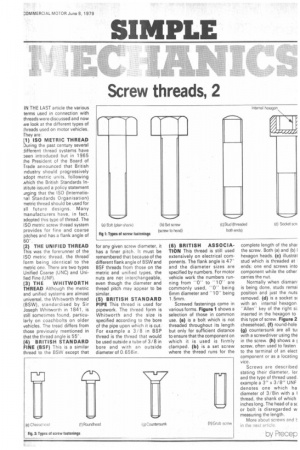Screw threads, 2
Page 81

If you've noticed an error in this article please click here to report it so we can fix it.
IN THE LAST article the various terms used in connection with threads were discussed and now we look at the different types of threads used on motor vehicles. They are: [1) ISO METRIC THREAD During the past century several Jifferent thread systems have Peen introduced but in 1965 the President of the Board of Trade announced that British industry should progressively adopt metric units, following which the British Standards Ingtitute issued a policy statement urging that the ISO (International Standards Organisation) metric thread should be used for 311 future designs. Many manufacturers have, in fact, adopted this type of thread. The ISO metric screw thread system provides for fine and coarse pitches and has a flank angle of 60.
(2) THE UNIFIED THREAD This was the forerunner of the ISO metric thread, the thread ' form being identical to the metric one. There are two types Unified Coarse (UNC) and Unified Fine (UNF).
(3) THE WHITWORTH THREAD Although the metric and unified systems are almost universal, the Whitworth thread (BSW), standardised by Sir Joseph Whitworth in 1841, is still sometimes found, particularly on coachbolts on older vehicles. The tread differs from those previously mentioned in that the thread angle is 55.
(4) BRITISH STANDARD FINE (BSF) This is a similar thread to the BSW except that for any given screw diameter, it has a finer pitch. It must be remembered that because of the different flank angle of BSW and BSF threads from those on the metric and unified types, the nuts are not interchangeable, even though the diameter and thread pitch may appear to be similar.
(5) BRITISH STANDARD PIPE This thread is used for pipework. The thread form is Whitworth and the size is specified according to the bore of the pipe upon which it is cut.For example a 3/8 in BSP thread is the thread that would be used outside a tube of 3/8 in bore and with an outside diameter of 0.656m.
(6) BRITISH ASSOCIATION This thread is still used extensively on electrical components. The flank angle is 47" and the diameter sizes are specified by numbers. For motor vehicle work the numbers running from "0" to "10— are commonly used, "0" being 6mm diameter and "10" being 1.5mm.
Screwed fastenings come in various forms. Figural shows a selection of those in common use. (a) is a bolt which is not threaded throughout its length but only for sufficient distance to ensure that the component on which it is used is firmly clamped. (b) is a set screw where the thread runs for the complete length of the shar the screw. Both (a) and (b) hexagon heads. (c) illustrai stud which is threaded at ends: one end screws into component while the other carries the nut.
Normally when disman is being done, studs remai position and just the nuts removed. (d) is a socket si with an internal hexagon "Allen" key of the right si: inserted in the hexagon to this type of screw. Figure 2 cheesehead, (f) round-hole (g) countersunk are all tui with a screwdriver using the in the screw. (h) shows a c screw, often used to fasten to the terminal of an elect component or as a locating vice.
Screws are described stating their diameter, ler and the type of thread used. example a 3" x 3/8#I UNF denotes one which ha diameter of 3/8in with a I thread, the shank of which inches long. The head of a sc or bolt is disregarded w measuring the length.
More about screws and in the next article.
by Precep




















































































































































